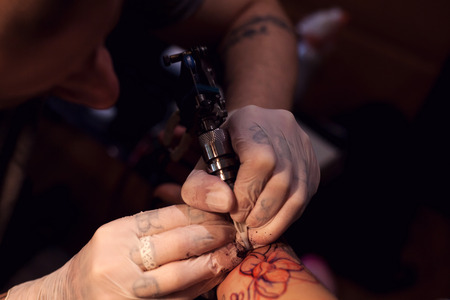Understanding Tattoo Removal for Darker Skin Tones
If you have a darker skin tone and are considering tattoo removal, it’s essential to understand how the process works uniquely for you. Unlike lighter skin, darker complexions possess higher levels of melanin—this is what gives our skin its rich hues and beautiful depth. Melanin also plays a key role in how your skin reacts to laser treatments, which are the most common method for removing unwanted ink. Laser tattoo removal targets pigment in both the tattoo and your skin, so there’s a science to ensuring effective results without causing unwanted side effects like hyperpigmentation or hypopigmentation. In my own journey and through conversations with others who share similar backgrounds, I’ve learned that knowledge truly is empowering here. The challenges faced by those with darker skin can be more pronounced, making it crucial to choose practitioners who understand these unique needs. Throughout this article, we’ll explore the science behind tattoo removal for darker skin tones, reveal why certain approaches may work better than others, and share best practices rooted in expert advice and lived experience.
2. Potential Risks and Complications
When considering tattoo removal for darker skin tones, it’s crucial to be aware of specific risks that are more prevalent due to the natural richness of melanin in the skin. While laser tattoo removal is generally safe, individuals with darker complexions—such as Fitzpatrick skin types IV to VI—may face unique challenges that require a highly skilled practitioner and a tailored approach.
Common Risks Associated with Tattoo Removal on Darker Skin
| Risk | Description | Frequency in Darker Skin |
|---|---|---|
| Pigmentation Changes | Changes in skin colour, either lightening (hypopigmentation) or darkening (hyperpigmentation) of the treated area. | More common; higher melanin increases risk. |
| Scarring | The formation of permanent scar tissue following treatment, often due to aggressive laser settings or improper aftercare. | Moderate; can be minimised with expert technique. |
| Keloid Formation | An overgrowth of scar tissue that extends beyond the original wound, creating raised, thickened scars. | Higher predisposition, especially among those with genetic tendency. |
Pigmentation Changes: A Personal Concern
In my experience, pigmentation changes are one of the most noticeable complications. After my first session, I noticed some patches were lighter than my natural tone—a result of hypopigmentation. Conversely, others might experience dark spots or hyperpigmentation as the skin reacts to trauma from the laser. These effects can be temporary but may persist if not managed properly, making professional assessment essential before starting treatment.
Keloids and Scarring: What You Should Know
If you have a history of keloid scarring—even from minor cuts or piercings—it’s vital to mention this during your consultation. Keloids are more likely to occur in darker skin due to increased collagen production during healing. In less experienced hands or with outdated equipment, there’s an elevated risk of both keloids and unsightly scars forming at the removal site. Choosing a clinic familiar with treating diverse skin types can significantly reduce these risks and lead to a smoother outcome.

3. Key Precautions Before Treatment
If you’re considering tattoo removal for darker skin tones, taking the right precautions before starting treatment is absolutely vital. The process is nuanced and requires careful preparation to reduce the risk of complications and achieve the best possible results.
Skin Assessments: Know Your Canvas
Your journey begins with a thorough skin assessment. A reputable specialist should evaluate your skin’s undertone, sensitivity, and any history of pigmentation issues such as hyperpigmentation or keloid scarring. This step helps tailor the treatment plan to your unique needs and minimises risks specific to melanin-rich skin.
Patch Testing: Safety First
Patch testing isn’t just a formality—it’s essential for darker skin tones. By applying the laser to a small test area, your practitioner can observe how your skin reacts over a few weeks. This allows them to adjust laser settings for safety and efficacy, reducing the likelihood of unwanted side effects like hypopigmentation or burns.
Selecting a Qualified Specialist
Choosing who performs your tattoo removal is one of the most important decisions you’ll make. Look for practitioners who have experience working with darker complexions and use advanced lasers such as Q-switched Nd:YAG. These devices are considered safer for deeper skin tones due to their specific wavelength and reduced risk of pigment disruption. Ask for before-and-after photos, check reviews, and don’t be shy about discussing qualifications—your skin deserves expert care.
Extra Tips Before You Begin
- Avoid sun exposure in the weeks leading up to your consultation—tanned or sunburnt skin increases risks.
- Be transparent about any skincare products you use, especially those containing retinoids or acids that may sensitise your skin.
- Prepare questions about aftercare routines, expected outcomes, and the total number of sessions required based on your tattoo and skin type.
Taking these precautions sets a solid foundation for safe, effective tattoo removal tailored specifically for darker skin tones. It’s all about giving yourself time, patience, and access to the right expertise on this transformative journey.
4. Best Practices During and After Treatment
When it comes to tattoo removal for darker skin tones, achieving safe and effective results is all about the right approach and diligent aftercare. Here are some tried-and-tested best practices that not only protect your skin but also maximise the outcome of each session.
Timing of Sessions
Spacing out your laser removal sessions is vital, especially for those with more melanin-rich skin. This gives your skin ample time to heal and reduces the risk of hyperpigmentation or scarring. Most specialists in the UK recommend waiting at least 8 to 12 weeks between sessions, but your practitioner may suggest a bespoke schedule based on your skin’s response.
Proper Aftercare
After each session, treating your skin with care is essential. This can make all the difference in how well you heal and how your skin looks post-treatment. Here’s a handy guide to aftercare essentials:
| Aftercare Step | Why It Matters |
|---|---|
| Keep area clean and dry | Minimises risk of infection |
| Apply recommended ointments | Soothes irritation and promotes healing |
| Avoid direct sun exposure | Prevents pigmentation changes |
| No picking or scratching | Reduces risk of scarring |
| Wear loose clothing | Prevents friction and irritation |
Lifestyle Considerations
Your day-to-day habits play a significant role in recovery and results. For instance, staying hydrated helps your body process ink fragments, while avoiding smoking can speed up healing. If you’re someone who loves sunbathing or tanning beds, it’s wise to put those on hold—UV exposure can increase the risk of dark spots and uneven skin tone.
Top Tips for an Easier Recovery
- Hydrate Well: Aim for 6–8 glasses of water daily to support skin regeneration.
- Avoid Harsh Products: Steer clear of strong exfoliants or retinols on the treated area.
- Listen to Your Practitioner: Follow their advice on when it’s safe to resume exercise or other activities.
A Final Note
The road to safe tattoo removal on darker skin tones is a blend of patience, knowledge, and attentive care. By following these best practices and working closely with an experienced professional, you’re giving yourself the very best chance of achieving beautifully clear skin without compromising its natural beauty.
5. Choosing the Right Clinic in the UK
When it comes to tattoo removal for darker skin tones, selecting a reputable clinic in the UK is absolutely crucial. As someone who’s witnessed both the highs and lows of laser treatments across London, Manchester, and beyond, I can’t stress enough how important it is to find practitioners who truly understand the unique needs of melanin-rich skin. Not every clinic has the expertise or right technology for safe and effective removal—especially when it comes to minimising risks such as hyperpigmentation or scarring.
What to Look For
Start by researching clinics that highlight their experience with Fitzpatrick skin types IV-VI. Reputable practitioners will be transparent about their qualifications and should be able to show a portfolio of before-and-after results specifically on darker skin. Don’t hesitate to ask about the types of lasers they use; Q-switched Nd:YAG lasers are generally considered safest for deeper skin tones, thanks to their longer wavelengths which target ink without overheating surrounding tissue.
Questions Worth Asking
- How many clients with similar skin tones have you treated?
- Which laser systems do you use, and why?
- Can you share testimonials or case studies relevant to my skin type?
- What aftercare protocols do you recommend for darker complexions?
Personal Comfort Matters
Your initial consultation should feel collaborative rather than salesy. A good practitioner will assess your tattoo and skin tone in detail, explain potential outcomes honestly, and never promise perfection. In my own journey, I found that clinics who prioritised education—walking me through risks, likely timelines, and aftercare—offered not just better results but a genuine sense of trust.
Check Reviews and Professional Affiliations
Don’t underestimate the value of word-of-mouth and independent reviews on UK platforms like Trustpilot or Google. Look for clinics accredited by professional bodies such as the British Association of Dermatologists or the British Medical Laser Association. These affiliations signal a commitment to safety and ongoing education—a must for anyone considering tattoo removal on darker skin.
The Bottom Line
The right clinic will combine technical expertise with an empathetic approach tailored to your individual story. Taking time to choose wisely isn’t just self-care—it’s essential for achieving clear, beautiful results while honouring the uniqueness of your skin.
6. Real Experiences and What to Expect
Hearing from those who’ve actually gone through tattoo removal in the UK, especially with darker skin tones, brings a genuine layer of insight you simply can’t get from clinic brochures alone. Many have shared that their journeys were as much about patience as they were about science. For instance, Aisha from Birmingham described feeling anxious before her first session, worrying about the risk of pigmentation changes, but was pleasantly surprised by her practitioner’s expertise and cultural sensitivity. She credits open communication and asking lots of questions as key to her positive outcome.
Another Londoner, Marvin, admitted he underestimated how gradual the process would be. He found it useful to join local online forums where people with similar skin tones exchanged advice about aftercare and choosing clinics experienced with melanin-rich skin. Marvin highlighted that while some fading took longer than expected, his commitment to following aftercare instructions (like diligent moisturising and sun protection) paid off, minimising any visible side effects.
Across these stories, several themes emerged: realistic expectations, selecting practitioners who understand diverse skin types, and prioritising safety over speed. Most agreed that while some initial redness or slight darkening did occur post-treatment, these effects faded with time when proper aftercare was followed. Importantly, many felt more confident once they found a practitioner who listened to their concerns rather than offering a one-size-fits-all solution.
If you’re considering tattoo removal on darker skin in the UK, these real experiences underscore that while risks exist, they can be managed with the right knowledge and support. It’s not just a physical process but an emotional journey too—one where informed choices and support networks make all the difference.


